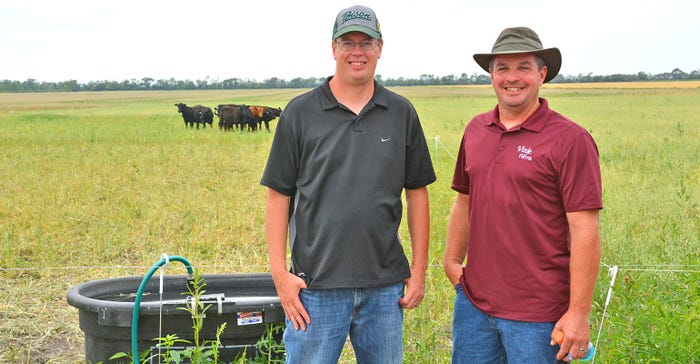January 9, 2018

Editor’s note: This is the second in an occasional series of articles about projects that didn’t work out as farmers and ranchers hoped. But these are not failures. Gabe Brown, a Bismarck, N.D., rancher who is a pioneer in the use of cover crops, no-till and intensive grazing systems to improve soil health and reduce input costs, once said, “I try to fail at something every year. If I don’t fail at something, it means I am not trying enough new things.”
Nick Vinje’s and Clint Severance’s cover crop grazing project didn’t turn out like they hoped last year.
They wanted to see if they could make money by grazing cattle on full season cover crops on high-quality cropland in North Dakota’s Red River Valley.
Severance, an engineer with Amity Technologies who raises free range poultry and pastured pork on an acreage, is interested in producing grass-finished beef to expand their product line. Vinje no-tills wheat, soybeans and corn. He is interested in getting livestock back on his cropland to provide fertilizer and increase soil organic matter
Vinje and Severance, who are from Gardner and Arthur, N.D., respectively, applied for a Sustainable Agriculture Research and Education grant to test their full-cover crop grazing idea. They divided 14 acres of cropland in half, and then planted rye in one half and field peas and oats in the other. They then divided each planting into several paddocks and rotated 12 head of yearling steers through the paddocks from May through October. They started grazing the rye in June, and moved the cattle to the field pea and oat mix in July. When they took the yearlings off the rye, they planted a warm season forage mix consisting of sorghum sudangrass, sunflowers, turnips and radishes.
 CATTLE VS. CROP: Clint Severance (left) and Nick Vinje (right), at field day last year, explained how they tried to substitute cattle and cover crops for one of the cash grains in Vinje’s no-till rotation.
CATTLE VS. CROP: Clint Severance (left) and Nick Vinje (right), at field day last year, explained how they tried to substitute cattle and cover crops for one of the cash grains in Vinje’s no-till rotation.

They hoped the cattle would gain 2 ½-3 pounds a day on the cover crops. If the cattle weighed about 650 pounds each when they turned them out, they would weigh 1,000 to 1,100 pounds at the end of the season and could be marketed as grass-finished beef.
But it didn’t turn out like they expected for several reasons:
1. The yearling cattle were light when they arrived at the farm, about 550 pounds instead of 650 pounds.
2. They missed the best time to graze the rye. Warm weather caused the rye to grow faster than they expected, and they didn’t get the cattle soon enough. Some of the rye had headed out by the time they turned the cattle into it. When rye starts to mature, the leaves don’t have as many nutrients in them as when are in the vegetative stage.
The animals gained more weight in field pea and oat mix, but that mix matured too quickly as well.
The same thing happened when they got to the warm season grasses. The forage quality was good for a while and then declined, and then the weather turned dry. The sorghum sudangrass and cover crops didn’t grow as quickly, or yield as much as they hoped. They had to supplement the yearlings with hay.
3. Two steers died. They had been band castrated three days before being moved to farm and turned out into the rye. None of the animals from the herd that they came from died after being banded. Vinje wonders if because their animals were grazing in head-high rye that their banded scrotums got infected by rye rubbing on them.
4. They discovered that some of the cover crop varieties they selected weren’t the best for grazing. They planted conventional field peas and radishes rather than forage peas and forage radishes because the seed was cheaper. The conventional field peas didn’t produce as many leaves as they expected, and the conventional radishes bolted seed heads instead of putting energy into leaves.
Next year
Vinje and Severance will try again the project again next year. They planted a mix of winter wheat, rye and hairy vetch last fall in the field pea and oat stubble. Because the winter wheat and rye mature at different times, there should be a longer period of peak forage quality. They plan to plant oats or barley with forage peas and forage brassicas in the spring. If the weather is dry, they’ll have a place to take the animals in case they don’t have the forage they need.
They adjusted their idea of success, too. Vinje just hopes to be able to pay for the cash rent and the carrying costs of the cattle. His profits from the system could come in reduced inputs and higher yields in the corn and soybean crops in the following years. He’d be happy if the cattle could take the place of some of the wheat he has been growing. The price of wheat has improved lately, but he lost money or barely broke even on wheat many years.
Not discouraged
Neither Severance nor Vinje is discouraged.
“I always tell my kids, ‘It’s not a failure if you learn something,’” Vinje says. “I’ll have to listen to my own advice.”
It helped that they started with just 14 acres, Severance says, and received a SARE grant.
“It didn’t turn out like we hoped, but it was a good start,” he says.
Did something you try not work? What did you learn? Contact me at 701-361-1105 or [email protected]
SEE RELATED ARTICLE IN FARMING FAILURES SERIES:
Soybean yield record attempt was a bust, but not a total loss
You May Also Like




